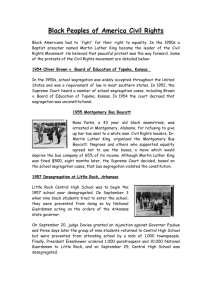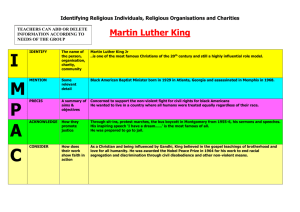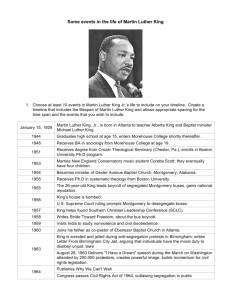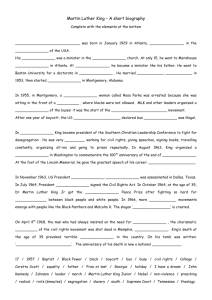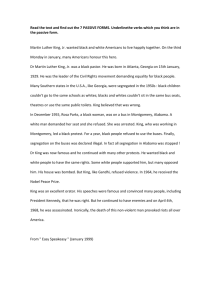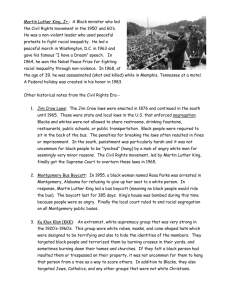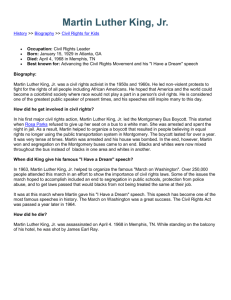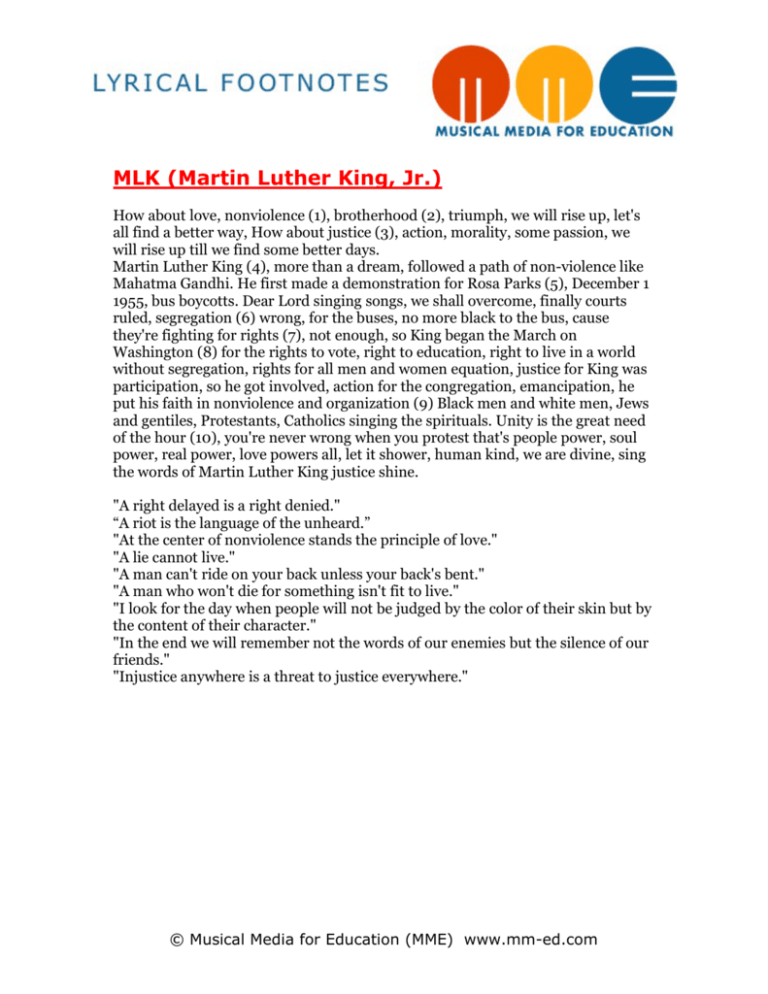
MLK (Martin Luther King, Jr.)
How about love, nonviolence (1), brotherhood (2), triumph, we will rise up, let's
all find a better way, How about justice (3), action, morality, some passion, we
will rise up till we find some better days.
Martin Luther King (4), more than a dream, followed a path of non-violence like
Mahatma Gandhi. He first made a demonstration for Rosa Parks (5), December 1
1955, bus boycotts. Dear Lord singing songs, we shall overcome, finally courts
ruled, segregation (6) wrong, for the buses, no more black to the bus, cause
they're fighting for rights (7), not enough, so King began the March on
Washington (8) for the rights to vote, right to education, right to live in a world
without segregation, rights for all men and women equation, justice for King was
participation, so he got involved, action for the congregation, emancipation, he
put his faith in nonviolence and organization (9) Black men and white men, Jews
and gentiles, Protestants, Catholics singing the spirituals. Unity is the great need
of the hour (10), you're never wrong when you protest that's people power, soul
power, real power, love powers all, let it shower, human kind, we are divine, sing
the words of Martin Luther King justice shine.
"A right delayed is a right denied."
“A riot is the language of the unheard.”
"At the center of nonviolence stands the principle of love."
"A lie cannot live."
"A man can't ride on your back unless your back's bent."
"A man who won't die for something isn't fit to live."
"I look for the day when people will not be judged by the color of their skin but by
the content of their character."
"In the end we will remember not the words of our enemies but the silence of our
friends."
"Injustice anywhere is a threat to justice everywhere."
© Musical Media for Education (MME) www.mm-ed.com
NOTES
1) Non-Violence: King found teachers of nonviolence in Jesus, Paul of Tarsus,
Henry David Thoreau, Mahatma Gandhi, and Bayard Rustin. The foundation of
non-violent resistance is the belief that the innermost essence of all people, even
one’s foes, is goodness. Standing up to an oppressor peacefully with honor,
courage, self-respect and love activates his conscience, transforming hatred to
right action.
2) Brotherhood: For King, oppressor and oppressed alike must realize their
common humanity to allow divisions based on religion, race, politics and class to
fall away. As he stated in the closing of the “I Have a Dream” speech: “When we
allow freedom ring . . . we will be able to speed up that day when all of God’s
children, black men and white men, Jews and gentiles, Protestants and Catholics,
will be able to join hands and sing in the words of the old Negro spiritual: Free at
Last! Free at Last.”
3) Justice: “When our days become dreary with low hovering clouds of despair,
and when our nights become darker than a thousand midnights, let us remember
that there is a creative force in this universe, working to pull down the gigantic
mountains of evil, a power that is able to make a way out of no way and transform
dark yesterdays into bright tomorrows. Let us realize the arc of the moral
universe is long but it bends toward justice.” – Martin Luther King Jr., A
Testament of Hope: Essential Writings of MLK, Jr.
4) Martin Luther King: King grew up within the African-American Baptist
church. Both his grandfather and father served as pastors of Ebenezer Baptist
Church in Atlanta, Georgia, King, Sr. from 1931 through 1975. “Daddy King”
preached, his mother played organ, and young “Mike” sang the gospel. As he
matured, King was fast tracked for the ministry. He skipped the 9th and 12th
grades, and at 15 years old, enrolled at Morehouse College, also in Atlanta. After
graduation, King continued his education at Crozer Theological Seminary in
Chester, Pennsylvania, where he received a B.D. (Bachelor of Divinity). He
studied “personalism” (the idea that G-d has a personal relationship with
humans) at Boston University for his Ph.D. Before he finished his doctorate, King
accepted an offer to become the full-time pastor of Dexter Avenue Baptist Church
in Montgomery, Alabama. On December 1, 1955 local activist Rosa Parks was
arrested after she refused to give her seat to a white man on a Montgomery bus.,
King stepped forward to lead the first major non-violent demonstration of the
Civil Rights Movement. The year-long bus boycott in Montgomery brought an
end to segregated busing in the city. A federal district court decision upheld by
the Supreme Court found racially segregated seating in public transportation to
© Musical Media for Education (MME) www.mm-ed.com
be unconstitutional. For King, the victory demonstrated the power of non-violent
resistance on a mass scale.
5) Rosa Parks: In 1955, Rosa Parks of Montgomery, Alabama refused the order
of a bus driver to give up her seat and move to the back of the bus. Her action
sparked the Montgomery Bus Boycott and symbolized courage, inspiring civil
rights activists and many Americans.
6) Segregation: Institutionalized de jure (legal) segregation froze racial
relationships in the South after Reconstruction. Jim Crow laws mandated
separate facilities for blacks and whites in every sphere of public life. “White” and
“Colored” signs, strict hierarchical norms, and the threat of violence rendered
blacks second class citizens. There were segregated schools, workplaces and
neighborhoods. Blacks were prevented from voting. Many children internalized
the status of inferiority forced upon them, carrying the effects of segregation from
one generation to the next. King explained it as a system of dehumanization.
“Segregation, to use the terminology of the Jewish philosopher Martin Buber,
substitutes an ‘I-it’ relationship for an ‘I-thou’ relationship and ends up
relegating persons to the status of things. Hence segregation is not only
politically, economically, and sociologically unsound, it is morally wrong and
sinful.” The first goal of King and the Civil Rights Movement was the dismantling
of Jim Crow. Their success on the ground was backed up by the federal
government in the form of the Civil Rights Act of 1964, the Voting Rights Act of
1965 and a number of important Supreme Court decisions.
7) Fighting for Rights: In 1963, King and his Southern Christian Leadership
Conference (SCLC) organized a nonviolent demonstration in Birmingham,
Alabama, the leading industrial city of the South. After meticulous planning, local
protestors and SCLC members marched in the city center. They were roughed up
and arrested, as King had expected. Soon the jails were crowded beyond capacity
as new demonstrators replenished the ranks of those who had been arrested.
From a solitary confinement cell, using the margins of the Birmingham News and
some paper smuggled in for him by an orderly, King wrote an everlasting treatise
about the moral imperative of confronting injustice in the form of a reply to a
group of white ministers who criticized him for coming to Birmingham. During
the second phase of the demonstration, the SCLC organized teenagers and
schoolchildren for a series of protest marches downtown, which became known
as the “Children’s Crusade.” On orders from Chief Eugene “Bull” Connor, a vocal
defender of segregation and a crude racist, the police attacked adults and
children with billy clubs, snarling dogs and fire hoses strong enough to knock
people off their feet. By now the violence in Birmingham appeared on the nightly
news and although television was still a growing influence, millions of Americans
became aware of conditions for blacks in the South and King’s struggle to change
© Musical Media for Education (MME) www.mm-ed.com
them. Public outrage coincided with more decisive support from the federal
government. Under pressure from the demonstrators, the Kennedy
administration and growing elements of the white establishment, Birmingham
yielded to most of King’s demands including the desegregation of public facilities
and the creation of a program to train blacks for better jobs.
8) March on Washington: On August 28, 1963, King delivered the “I Have a
Dream” speech to 250,000 civil rights supporters from the steps of the Lincoln
Memorial during the March on Washington for Jobs and Freedom.
9) Organization: Although King personified civil rights in the early 1960s, the
Movement was a loose coalition of united organizations including King’s SCLC,
SNCC (Student Non-Violent Coordinating Committee), CORE (Congress of Racial
Equality), the NAACP (National Association for the Advancement of Colored
People), and others. Bayard Rustin, Andrew Young, and Ralph Abernathy served
as King’s top advisors, while activists such as Ella Baker, Fannie Lou Hamer and
Medgar Evers connected the grass-roots with the leadership. King held the SCLC
together through periods of ruinous internal dissension even as he clashed with
allied organizations over strategy and tactics. The black church was the
foundation of the Movement, providing financial support as well as places to
recruit, organize and take shelter.
10) Unity: In a pep talk before launching the Montgomery bus boycott in 1955,
King exhorted his followers to remain unified. “I want to say that in all of our
actions we must stick together. Unity is the great need of the hour. And if we are
united we can get many of the things we not only desire but which we justly
deserve. And don’t let anybody frighten you. We are not afraid of what we are
doing, because we are doing it within the law. There is never a time in our
American democracy that we must ever think we’re wrong when we
protest.”(Martin Luther King, Jr., December 5, 1955)
11) Riot is the Voice of the Unheard: King’s focus on racial justice in the late
’50s and early ’60s tends to overshadow his long-standing condemnation of class
inequality. After 1965, when the focus of the Movement turned to urban ghettoes
in the North, King became a strong advocate of wealth redistribution, questioning
whether equal opportunity was possible within the framework of capitalism.
Songwriters-Mitch Monsour & Lance Fialkoff; Vocals, Guitar, Drums & BassGary Levitt; Backup Vocals-Erica Quitzow~Young Love Studio, New Paltz, NY ©
2008. All Rights Reserved. Musical Media for Education (MME)
© Musical Media for Education (MME) www.mm-ed.com

